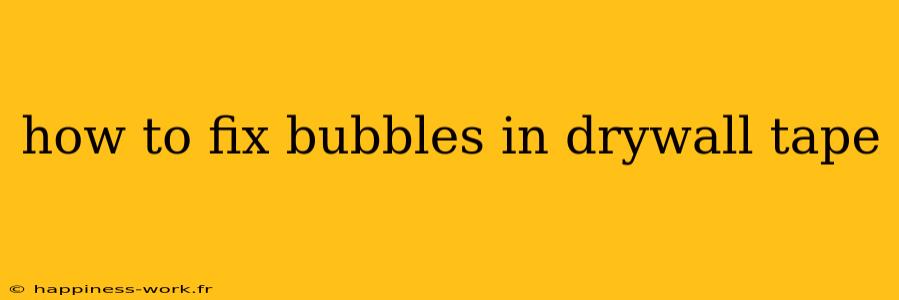Drywall tape is essential for creating a smooth and seamless finish in any drywall installation. However, over time, you might notice unsightly bubbles forming in your tape, which can compromise the appearance and integrity of your walls. In this article, we'll explore common questions about fixing bubbles in drywall tape, drawing insights from Wikihow while adding our own analysis, practical examples, and additional tips to ensure a professional finish.
What Causes Bubbles in Drywall Tape?
Before diving into the solutions, it’s important to understand the causes of these bubbles. According to Wikihow's article on fixing bubbles in drywall tape, some common reasons include:
- Improper application: When applying tape, if mud isn't pressed firmly enough against the tape, air pockets can form.
- Moisture: Excess moisture in the drywall or compound can lead to tape loosening and bubbling.
- Incompatible materials: Using different types of joint compounds can also cause adhesion issues.
How Can I Fix Bubbles in Drywall Tape?
1. Assess the Damage
Before starting any repair, assess how severe the bubble is. Small bubbles can often be repaired with minor adjustments, while larger sections may require more extensive work. If the bubble is larger than a few inches, consider removing the tape entirely.
2. Tools and Materials You Will Need
- Utility knife
- Putty knife (6-inch)
- Drywall compound (joint compound)
- Sandpaper (medium and fine grit)
- Primer and paint (if necessary)
3. Repairing Small Bubbles
For minor bubbles, follow these steps:
-
Cut into the Bubble: Use a utility knife to slice the bubble open. Be careful not to cut too deeply into the drywall itself.
-
Apply Compound: Use a putty knife to spread a small amount of drywall compound under the lifted section of tape. Ensure you press the tape down firmly to remove any air.
-
Smooth Out: Apply more joint compound over the bubble to blend it into the surrounding area. Feather the edges with your putty knife to create a smooth transition.
-
Sand and Prime: Once dry, sand the area until smooth, and then apply primer and paint as needed.
4. Repairing Larger Bubbles
If the bubble is too large, it might be best to remove the section of tape entirely.
-
Remove the Tape: Use a utility knife to carefully cut out the affected section of tape. Remove any loose joint compound that may be present.
-
Clean the Surface: Ensure the drywall surface is clean and free of dust or debris.
-
Reapply Tape: Cut a new piece of drywall tape to size, and apply it over the seam, pressing it firmly into place.
-
Apply Compound: Use the putty knife to cover the tape with joint compound. Spread it evenly and feather the edges.
-
Sand and Finish: After the compound has dried, sand it smooth. Prime and paint the area to match the surrounding wall.
Additional Tips for Preventing Future Bubbles
-
Choose the Right Compound: Ensure you're using a compatible joint compound for your tape. Some compounds are specifically designed for certain types of drywall tape.
-
Proper Application Technique: Always apply enough compound to bed the tape properly. This minimizes the chance of air pockets.
-
Dry Conditions: When finishing drywall, ensure the room is dry and at a consistent temperature. High humidity can increase the risk of bubbles forming.
-
Patience is Key: Allow each coat of compound to dry completely before sanding or adding more layers.
Conclusion
Repairing bubbles in drywall tape doesn't have to be an overwhelming task. By understanding the causes and employing the right techniques, you can achieve a smooth finish that enhances the appearance of your walls. Whether you're dealing with minor imperfections or larger sections of bubbling tape, this guide will help you tackle the problem efficiently.
By taking care of your drywall installation with proper techniques and materials, you can avoid future complications.
For further detailed guidance and visual tutorials, consider checking out the original article on Wikihow (source), written by experienced DIY enthusiasts who provide valuable insight into home improvement projects.
Happy renovating!
